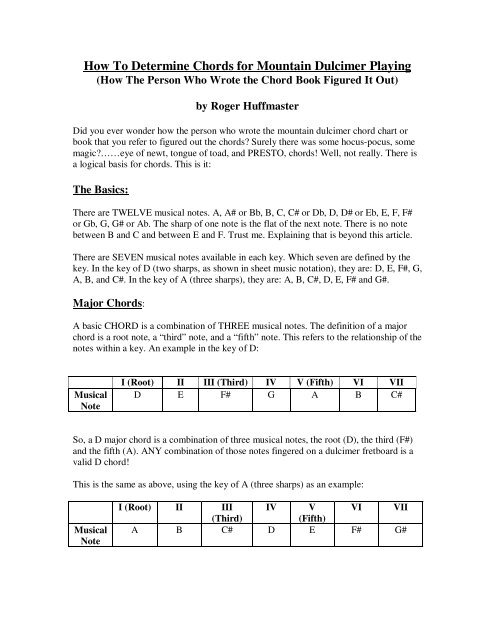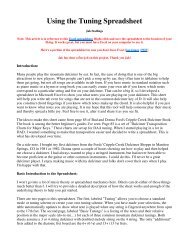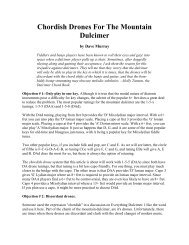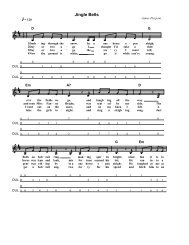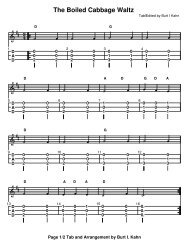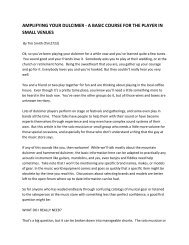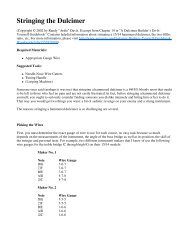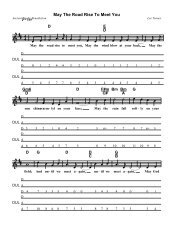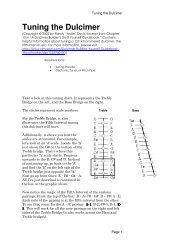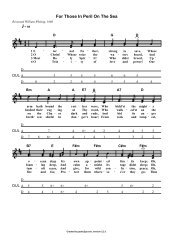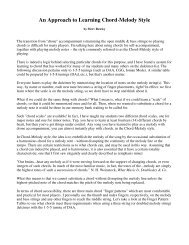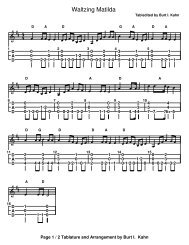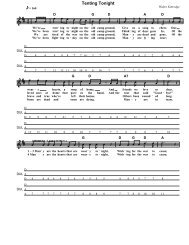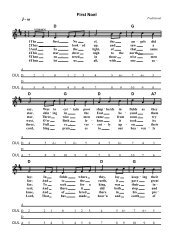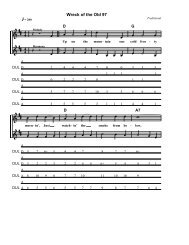How To Determine Chords for Mountain Dulcimer Playing
How To Determine Chords for Mountain Dulcimer Playing
How To Determine Chords for Mountain Dulcimer Playing
Create successful ePaper yourself
Turn your PDF publications into a flip-book with our unique Google optimized e-Paper software.
<strong>How</strong> <strong>To</strong> <strong>Determine</strong> <strong>Chords</strong> <strong>for</strong> <strong>Mountain</strong> <strong>Dulcimer</strong> <strong>Playing</strong>(<strong>How</strong> The Person Who Wrote the Chord Book Figured It Out)by Roger HuffmasterDid you ever wonder how the person who wrote the mountain dulcimer chord chart orbook that you refer to figured out the chords? Surely there was some hocus-pocus, somemagic?……eye of newt, tongue of toad, and PRESTO, chords! Well, not really. There isa logical basis <strong>for</strong> chords. This is it:The Basics:There are TWELVE musical notes. A, A# or Bb, B, C, C# or Db, D, D# or Eb, E, F, F#or Gb, G, G# or Ab. The sharp of one note is the flat of the next note. There is no notebetween B and C and between E and F. Trust me. Explaining that is beyond this article.There are SEVEN musical notes available in each key. Which seven are defined by thekey. In the key of D (two sharps, as shown in sheet music notation), they are: D, E, F#, G,A, B, and C#. In the key of A (three sharps), they are: A, B, C#, D, E, F# and G#.Major <strong>Chords</strong>:A basic CHORD is a combination of THREE musical notes. The definition of a majorchord is a root note, a “third” note, and a “fifth” note. This refers to the relationship of thenotes within a key. An example in the key of D:MusicalNoteI (Root) II III (Third) IV V (Fifth) VI VIID E F# G A B C#So, a D major chord is a combination of three musical notes, the root (D), the third (F#)and the fifth (A). ANY combination of those notes fingered on a dulcimer fretboard is avalid D chord!This is the same as above, using the key of A (three sharps) as an example:MusicalNoteI (Root) II III IV V VI VII(Third)(Fifth)A B C# D E F# G#
In the key of A, an A major chord is the root (A), the third (C#), and the fifth (E). Anycombination of those notes fingered on a dulcimer is a valid A chord.These are the notes on a mountain dulcimer fretboard up to the 10 th fret when tuned inDAD (Mixolydian):Fret 0 1 2 3 4 5 6 6 ½ 7 8 9 10Number: (open)Bass D E F# G A B C C# D E F# GMiddle A B C# D E F# G G# A B C# DMelody D E F# G A B C C# D E F# GIt can be seen that there are several possibilities <strong>for</strong> a valid D major chord. With the openstrings as DAD, simply fretting either D string at the second fret gives you a D, A and anF# note, which is a D chord. Fretting the bass string at the second fret(F#), the middlestring at the third fret(D) and the melody string(s) at the fourth fret (A) gives another Dchord. Or even fretting the bass string at the seventh fret (D), the middle string at theseventh fret (A) and the melody string(s) at the ninth fret (F#)….this also gives a D chord.For the A major chord, one possibility is fretting the bass string at the first fret (E), themiddle string at the second fret (C#) and the melody string(s) at the fourth fret (A).Another is the bass string at the fourth fret (A), the middle string at the fourth fret (E),and the melody string(s) at the 6 ½ fret (C#). Any combination of the A, C# and E notesis a valid A major chord.Minor <strong>Chords</strong>:Now…..how are MINOR chords created? The definition of a minor chord is a root, a fifthand a FLATTED third. What this means is the note that was used <strong>for</strong> the third in a majorchord is reduced one-half step to make it flat (lower in pitch) relative to the normal third.So…..a D-minor chord is made up of the notes D, A and F (NOT F#). The A-minorchord is made up of the notes A, E and C (NOT C#).Since a mountain dulcimer is not a chromatic instrument (with all notes available on thefretboard, like a guitar), the flatted notes are not available unless you happen to have ahalf-fret available at the right place. This limits the availability of true minor chords onthe mountain dulcimer. Looking at the fret board in DAD tuning above, it can be seenthat there is no F note available, so no D-minor chord is possible. An A-minor chord ispossible if you fret the bass and middle strings at the 4 th fret, and the melody string(s) atthe 6 th fret, or the bass at the 6 th fret and the middle and melody strings at the 4 th fret.If the flatted third is not available to make a true minor chord, what do you do?
<strong>Chords</strong> Neither Major Nor Minor – “Fifth” or “Power” <strong>Chords</strong>There exists chords that are neither major nor major. They are called “5” or “fifth” chords(like A5, B5, C5…), but to those familiar with rock music, they are called “powerchords”, as they are used extensively in rock and heavy metal music. These chordsconsist of only the root note plus the fifth note, with no third note used to create the chord.Since the third note is what determines whether the chord is major or minor, these chordsare NEITHER. They simply provide the base chord tone.This simplifies playing a mountain dulcimer if properly applied. Again, here are the noteson the fretboard in DAD tuning:Fret 0 1 2 3 4 5 6 6 ½ 7 8 9 10Number: (open)Bass D E F# G A B C C# D E F# GMiddle A B C# D E F# G G# A B C# DMelody D E F# G A B C C# D E F# GFor the D5 chord, all that is required is to fret the D (root) and the A (fifth) notes. For theA5 chord, the A (root) and E (fifth) notes are required. It can seen above that the D andA notes <strong>for</strong> the D5 are very nicely all in the same fret!!!! Ditto <strong>for</strong> the A5 chord, the Aand E notes are in the same fret.So, a D5 chord can be played by simply strumming the open strings of a DAD-tunedmountain dulcimer. Hold down all the strings at the first fret and a E5 chord can beplayed. F#5 at the second fret, G5 at the third fret, A5 at the fourth fret, and so on up thefretboard.Since the fifth chord is neither major nor minor, it can be used interchangeably wheneither a major or minor chord is needed. A useful survival technique when playing amountain dulcimer in a jam, especially if the songs are key of D, is to simply barre chord(hold all the strings down) at a fret. The open strum is D, the third fret is G and the fourthfret is A. The barre chords <strong>for</strong> these can be used when either major or minor chords arerequired. If a B-minor chord is required <strong>for</strong> a song, barre chording the fifth fret will serveperfectly well.The following table summarizes what fifth chords are available at each fret in DAD orDAA tuning:FretNumber:Chord0(open)D orDm1 2 3 4 5 6 6 ½ 7 8 9 10EorEmF#orF#mGorGmAorAmBorBmCorCmC#orC#mDorDmEorEmF#orF#mGorGm
Dominant Seventh <strong>Chords</strong>The other type of chord commonly used in mountain dulcimer playing is the dominantseventh chord, written as A7, D7, etc. The dominant seventh chord is created by addingthe FLATTED “seventh” note to the root, third and fifth used <strong>for</strong> a major chord.The notes in the key of D, with the seventh illustrated:MusicalNoteI (Root) II III (Third) IV V (Fifth) VI VII(Seventh)D E F# G A B C#The notes in the key of A, with the seventh illustrated:MusicalNoteI (Root) II III IV V VI VII(Third)(Fifth)(Seventh)A B C# D E F# G#With a mountain dulcimer with 3 courses of strings (a doubled pair is one course), it canbe seen that it is impossible to create four different notes simultaneously, so a truedominant seventh chord is not possible. <strong>How</strong>ever, one can do a partial dominant seventhchord by fingering THREE of the four notes; preferably the root and the seventh shouldbe used with either the third or fifth.For the D7 chord, the four notes to be used are D, F#, A and C(the flatted note to C#), soa good partial D7 would be any combination of D, F# and C or D, A, and C.For the A7 chord, the four notes are A, C#, E and G(the flatted note to G#), so a goodpartial A7 would be A, C# and G, or A, E and G.Tunings Other Than Mixolydian (DAD)<strong>How</strong> do the principles of determining chords stated above apply to other tunings? Theprinciples do not change, simply the frets at which the chords are played. Thedetermination of major, minor, fifth and seventh chords is exactly the same, using thesame notes.Roger HuffmasterED screen name – “DulciGander”rhuffmas@yahoo.comVersion 1.01 – June 27, 2005
Appendix 1 – Notes On Each String For Common TuningsNotes at each fret position <strong>for</strong> common string tunings, to assist you in determining yourown chords:Fret 0 1 2 3 4 5 6 6 ½ 7 8 9 10Number: (open)Note: A B C# D E F# G G# A B C# DFret 0 1 2 3 4 5 6 6 ½ 7 8 9 10Number: (open)Note: B C# D# E F# G# A A# B C# D# EFret 0 1 2 3 4 5 6 6 ½ 7 8 9 10Number: (open)Note: C D E F G A B C D E F GFret 0 1 2 3 4 5 6 6 ½ 7 8 9 10Number: (open)Note: D E F# G A B C C# D E F# GFret 0 1 2 3 4 5 6 6 ½ 7 8 9 10Number: (open)Note: E F# G# A B C# D D# E F# G# AFret 0 1 2 3 4 5 6 6 ½ 7 8 9 10Number: (open)Note: F# G# A# B C# D# E F F# G# A# BFret 0 1 2 3 4 5 6 6 ½ 7 8 9 10Number: (open)Note: G A B C D E F F# G A B CNote: As in all things with a human involvement, mistakes are possible, so if you believeyou have found a mistake, please contact me at rhuffmas@yahoo.com and let me know.Thank you.
Appendix 2 – Mixolydian (DAD) <strong>Chords</strong>:Given as fret numbers <strong>for</strong> each of the three courses, from bass to middle to melody.Fret 0 1 2 3 4 5 6 6 ½ 7 8 9 10Number: (open)Bass D E F# G A B C C# D E F# GMiddle A B C# D E F# G G# A B C# DMelody D E F# G A B C C# D E F# GA: (notes are A, C# and E) 124, 421, 446, 644, 6½ 78, 876½, 6½ 08, 806½A5: (notes are A and E) 444, 104, 401A7 (partial): (notes are A, C# and G, or A, E and G) 423, 324, 103, 301B: (notes are B, D# and F#) None possible, no D# note availableB5: (notes are B and F#) 555, 212B7 (partial): (notes are B, D# and A or B, F# and A) 554, 455, 502, 205C: (notes are C, E and G) 643, 346, 668, 866C5: (notes are C and G) 666C7 (partial): (notes are C, E and A#, or C, G and A#) None possible, no A# noteavailableD: (notes are D, F# and A) 002, 200, 234, 432, 779, 977, 754, 457D5: (notes are D and A) 000, 777, 034, 430D7 (partial): (notes are D, F# and C, or D, A and C) 006, 600, 756, 657E: (notes are E, G# and B) 8 6 ½ 5, 5 6 ½ 8E5: (notes are E and B) 111, 888, 145, 541E7 (partial): (notes are E, G# and D, or E, B and D) 8 6 ½ 7, 7 6 ½ 8, 110, 011, 887, 788,880, 088F: None possible, no F note availableF#: (notes are F#, A# and C#) None possible, no A# note availableF#5: (notes are F# and C#) 222, 999, 256½, 6½ 52G: (notes are G, B and D) 310, 013, 335, 533, 567, 765, 78 10, 10 87G5: (notes are G and D) 333, 10 10 10, 063, 360G7 (partial): (notes are G, B and F or G, D and F) None possible, no F note availableNote: As in all things with a human involvement, mistakes are possible, so if you believeyou have found a mistake, please contact me at rhuffmas@yahoo.com and let me know.Thank you.
Appendix 3 – Ionian (DAA) <strong>Chords</strong>:Given as fret numbers <strong>for</strong> each of the three courses, from bass to middle to melody.Fret 0 1 2 3 4 5 6 6 ½ 7 8 9 10Number: (open)Bass D E F# G A B C C# D E F# GMiddle A B C# D E F# G G# A B C# DMelody A B C# D E F# G G# A B C# DA: (notes are A, C# and E) 120, 102, 442, 424, 6 ½ 7 4, 6 ½ 4 7A5: (notes are A and E) 444, 100, 401A7 (partial): (notes are A, C# and G, or A, E and G) 6 ½ 7 6, 6 ½ 6 7, 446, 464, 304, 340,876, 867B: (notes are B, D# and F#) None possible, no D# note availableB5: (notes are B and F#) 555, 211B7 (partial): (notes are B, D# and A or B, F# and A) 550, 505, 557, 575C: (notes are C, E and G) 646, 664C5: (notes are C and G) 666C7 (partial): (notes are C, E and A#, or C, G and A#) None possible, no A# noteavailableD: (notes are D, F# and A) 050, 005, 203, 230, 757, 775, 9 7 10, 9 10 7D5: (notes are D and A) 000, 777, 030, 003, 433D7 (partial): (notes are D, F# and C, or D, A and C) 603, 630E: (notes are E, G# and B) 8 6 ½ 8, 5 6 ½ 4E5: (notes are E and B) 111, 888, 141, 544E7 (partial): (notes are E, G# and D, or E, B and D) 014, 041, 4 6 ½ 7, 7 4 6 ½, 113, 131,543, 534, 8 8 10, 8 10 8F: None possible, no F note availableF#: (notes are F#, A# and C#) None possible, no A# note availableF#5: (notes are F# and C#) 222, 999, 6½ 5 5G: (notes are G, B and D) 313, 331, 768, 786, 563, 536G5: (notes are G and D) 333, 10 10 10, 066, 363G7 (partial): (notes are G, B and F or G, D and F) None possible, no F note availableNote: As in all things with a human involvement, mistakes are possible, so if you believeyou have found a mistake, please contact me at rhuffmas@yahoo.com and let me know.Thank you.


